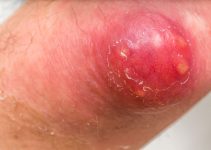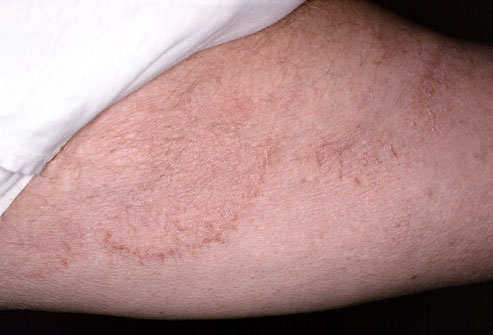Still reminiscing the wolfman-like guy you saw perform at the circus lately? Chances are, that he is suffering from a condition called Hypertrichosis. Read on to get more Hypertrichosis information. Know what is Hypertrichosis and the causes, symptoms, diagnosis and treatment of the syndrome.
Hypertrichosis Definition
Page Contents
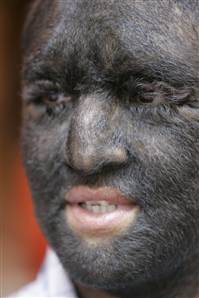
Picture 1 – Hypertrichosis
Source – msn
Hypertrichosis is a condition that is characterized by excessive hair growth. The disease can be localized, meaning a particular region of the body can be affected by it and show excess hair growth. The disorder may also be generalized. In such a case there can be abnormal growth of hair from the entire skin surface of the body.
Hypertrichosis disease is also known as “Werewolf Syndrome”. Sadly, people with this syndrome are laughed at in the society. Hypertrichosis women attract a lot of attention in society while many men with this disease perform in circuses and sideshows to earn a living.
Hypertrichosis is pronounced as “Hai-par-tri-hoh-sis”.
Hypertrichosis Frequency
Hypertrichosis is very rare in the United States and affects only a few people every year.
Types of Hypertrichosis
Hypertrichosis is usually of two types. These are :
Congenital Hypertrichosis
As the name suggests, Congenital Hypertrichosis arises as a result of a congenital defect or defect that has been present since birth. This is a rare syndrome. It has several subtypes like
- Congenital Hypertrichosis Lanuginosa
- Congenital Generalized Hypertrichosis
- Congenital Terminal Hypertrichosis
- Congenital Circumscribed Hypertrichosis
- Congenital Localized Hypertrichosis
- Congenital Nevoid Hypertrichosis
Acquired Hypertrichosis
This disorder arises in sufferers after birth. It can result as a side effect of medicines and from a variety of factors like eating disorders and cancer. It is classified into several subtypes such as
- Acquired Hypertrichosis Lanuginosa
- Acquired Generalized Hypertrichosis
- Acquired Patterned Hypertrichosis
- Acquired Localized Hypertrichosis
Hypertrichosis Symptoms
The symptoms of Hypertrichosis mainly include excessive hair growth. The condition affects members of either sex.
A fine layer of hair called Lanugo normally covers the fetus and falls of sometime before the fetus comes out of the womb. In case of Congenital Hypertrichosis sufferers, the Lanugo continues to grow. In serious cases like Congenital Hypertrichosis Terminalis, the hair turns colored and does not fall off but remains after birth.
In Naevoid Hypertrichosis, the sufferer has excessive hair in only one part of the body. But in Acquired Hypertrichosis sufferers, the hair growth can arise in a single region or in the entire body.
Causes of Hypertrichosis
Some of the most notable Hypertrichosis causes are :
Gene
Hypertrichosis is supposed to be a congenital defect. In Hypertrichosis mutation of genes is thought to be a factor.
In patients of Hypertrichosis genetic disorders are held to be one of the main causative factors. However in Hypertrichosis genetics is medically seen as a rare cause.
Drugs
Hypertrichosis is believed to result as a side-effect of certain drugs. In Hypertrichosis medicines like Cyclosporine, Vasodilator, Minoxidil and Phenetoina can lead to an imbalance in the hormone levels and affect the glands involved in hair production. Anabolic Steroids and Androgenic Oral Contraceptives are also seen as causative factors.
Metabolic Disorder
The disease can also arise from irregularities in the metabolism.
Cancer
Hypertrichosis is also seen to arise after a person begins to suffer from cancer. Cancer is supposed to be one of the major Hypertrichosis causes. Hair growth becomes normal once again after the affected part is removed.
Hypertrichosis Diagnosis
The diagnosis of Hypertrichosis cases is done by physical observation, asking the patient about any special medicines that he or she has been taking and taking his or her medical history into account.
Treatment for Hypertrichosis
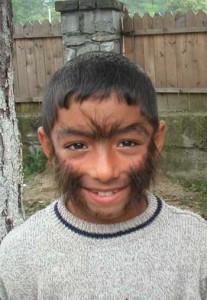
Picture 2 – Hypertrichosis Picture
Source – canadianmedicine4all
Here are some of the best steps used for the Hypertrichosis treatment.
Regular Shaving
For sufferers of Hypertrichosis shaving off all the body hair regularly in the morning is the best way to avoid landing up with a hairy appearance.
Use of Depilatories
You can also use Depilatories or hair removal creams for a clean appearance. Check that you do not have an open wound or cut on your skin surface before use of such creams. You may suffer from allergenic reactions otherwise.
Electrolysis
Electrolysis can help in effective hair removal.
Laser Hair Removal
People with Hypertrichosis Werewolf Syndrome may also try Laser Hair Removal to get rid of unwanted hair. Laser rays destroy the follicle that produces hair thus making hair growth stop from the root.
There is still no effective Hypertrichosis cure. In Hypertrichosis medicines are proved to be ineffective for treatment. But the aforementioned ways have proved to be effective for Hypertrichosis treatment.
Hypertrichosis Vs Hirsutism
Hypertrichosis is often confused with Hirsutism. But Hypertrichosis and Hirsutism are two different conditions. Hypertrichosis is marked by an excess of hair growth on the body, mainly resulting from an endocrine dysfunction. Hirsutism on the other hand, results from an increase in levels of androgen.
Hypertrichosis Pictures
Want to know how Hypertrichosis patients look like? Here are some useful Hypertrichosis images to help you out. These Hypertrichosis photos will help you get an idea about the condition.
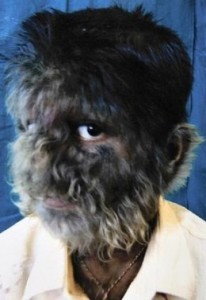
Picture 3 – Hypertrichosis Photo
Source – blogspot
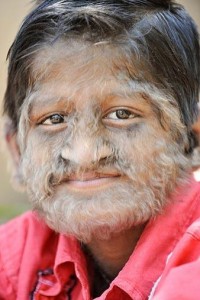
Picture 4 – Hypertrichosis Image
Source – medicalassistants
If you know someone close to you displaying Hypertrichosis effects or if you are suffering from it yourself, it is best that you get in touch with a doctor. You may also try hair removal if you are advised.
References:
http://en.wikipedia.org/wiki/Hypertrichosis#Hirsutism
http://www.nlm.nih.gov/medlineplus/ency/article/003148.htm
http://www.wisegeek.com/what-is-hypertrichosis.htm
http://www.hypertrichosis.com/hypertrichosis-biology/what-hypertrichosis.shtml
http://emedicine.medscape.com/article/1072987-overview
http://hairgrowth.tv/hypertrichosis-extra-hair-growth-and-removal/70/

